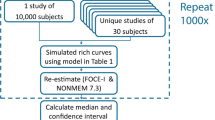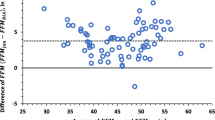Abstract
Background
Fat-free mass (FFM) is an important covariate for predicting drug clearance. Models for predicting FFM have been developed in adults but there is currently a paucity of mechanism-based models developed to predict FFM in children.
Objective
The aim of this study was to develop and evaluate a model to predict FFM in children.
Methods
A large dataset (496 females and 515 males) was available for model building. Subjects had a relatively wide range of age (3–29 years) and body mass index values (12–44.9 kg/m2). Two types of models (M1 and M2) were developed to describe FFM in children. M1 was fully empirical and based on a linear model that contained all statistically significant covariates and their interactions. M2 was a simpler model that incorporated a maturation process. M1 was developed to provide the best possible description of the data (i.e. a positive control). In addition, a published adult model (M3) was applied directly as a reference description of the data. The predictive performances of the three models were assessed by visual predictive checks and by using mean error (ME) and root mean squared error (RMSE). A test dataset (90 females and 86 males) was available for external evaluation.
Results
M1 consisted of nine terms with up to second-level interactions. M2 was a sigmoid hyperbolic model based on postnatal age with an asymptote at the adult prediction (M3). For the index dataset, the ME and 95 % CI for M1, M2 and M3 were 0.09 (0.03–0.16), 0.24 (0.14–0.33) and 0.29 (0.06–0.51) kg, respectively, and RMSEs were 1.12 (1.03–1.23), 1.58 (1.46–1.72) and 3.76 (3.54–3.97) kg.
Conclusions
A maturation model that asymptoted to an established adult model was developed for prediction of FFM in children. This model was found to perform well in both male and female children; however, the adult model performed similarly to the maturation model for females. The ability to predict FFM in children from simple demographic measurements is expected to improve understanding of human body structure and function with direct application to pharmacokinetics.




Similar content being viewed by others
References
Shen W, St-Onge M, Wang Z, Heymsfield SB. Study of body composition: an overview. In: Heymsfield SB, Lohman TG, Wang Z, Going SB, editors. Human body composition. 2nd ed. Champaign: Human Kinetics; 2005.
Green B, Duffull SB. What is the best size descriptor to use for pharmacokinetic studies in the obese? Br J Clin Pharmacol. 2004;58(2):119–33.
Han PY, Duffull SB, Kirkpatrick CM, Green B. Dosing in obesity: a simple solution to a big problem. Clin Pharmacol Ther. 2007;82(5):505–8.
Cortinez LI, Anderson BJ, Penna A, Olivares L, Munoz HR, Holford NH, et al. Influence of obesity on propofol pharmacokinetics: derivation of a pharmacokinetic model. Br J Anaesth. 2010;105(4):448–56.
Roubenoff R, Kehayias JJ. The meaning and measurement of lean body mass. Nutr Rev. 1991;49(6):163–75.
Moore FD. Energy and the maintenance of the body cell mass. JPEN J Parenter Enteral Nutr. 1980;4(3):228–60.
Janmahasatian S, Duffull SB, Ash S, Ward LC, Byrne NM, Green B. Quantification of lean bodyweight. Clin Pharmacokinet. 2005;44(10):1051–65.
Lohman TG. Applicability of body composition techniques and constants for children and youths. Exerc Sport Sci Rev. 1986;14:325–57.
Cronk CE, Roche AF, Kent R, Berkey C, Reed RB, Valadian I, et al. Longitudinal trends and continuity in weight/stature from 3 months to 18 years. Hum Biol. 1982;54(4):729–49.
Rhodin MM, Anderson BJ, Peters AM, Coulthard MG, Wilkins B, Cole M, et al. Human renal function maturation: a quantitative description using weight and postmenstrual age. Pediatr Nephrol. 2009;24(1):67–76.
Ejlerskov KT, Jensen SM, Christensen LB, Ritz C, Michaelsen KF, Mølgaard C. Prediction of fat-free body mass from bioelectrical impedance and anthropometry among 3-year-old children using DXA. Sci Rep. 2014;4:3889.
Nielsen BM, Dencker M, Ward L, Linden C, Thorsson O, Karlsson MK, et al. Prediction of fat-free body mass from bioelectrical impedance among 9- to 11-year-old Swedish children. Diabetes Obes Metab. 2007;9(4):521–39.
Foster BJ, Platt RW, Zemel BS. Development and validation of a predictive equation for lean body mass in children and adolescents. Ann Hum Biol. 2012;39(3):171–82.
Anderson BJ, Holford NHG. Mechanistic basis of using body size and maturation to predict clearance in humans. Drug Metab Pharmacokinet. 2009;24(1):25–36.
Crawford JD, Terry ME, Rourke GM. Simplification of drug dosage calculation by application of the surface area principle. Pediatrics. 1950;5(5):783–90.
Anderson BJ, Holford NH. Mechanism-based concepts of size and maturity in pharmacokinetics. Annu Rev Pharmacol Toxicol. 2008;48:303–32.
Bachrach LK. Dual energy X-ray absorptiometry (DEXA) measurements of bone density and body composition: promise and pitfalls. J Pediatr Endocrinol Metab. 2000;13(Suppl 2):983–8.
Mattsson S, Thomas BJ. Development of methods for body composition studies. Phys Med Biol. 2006;51(13):R203–28.
Pietrobelli A, Peroni DG, Faith MS. Pediatric body composition in clinical studies: which methods in which situations? Acta Diabetol. 2003;40(Suppl 1):S270–3.
Lohman TG, Chen Z. Dual-energy x-ray absorptiometry. In: Heymsfield SB, Lohman TG, Wang Z, Going SB, editors. Human body composition. 2nd ed. Champaign: Human Kinetics; 2005.
Taylor RW, Grant AM, Williams SM, Goulding A. Sex differences in regional body fat distribution from pre- to postpuberty. Obesity (Silver Spring). 2010;18(7):1410–6.
Beal S, Sheiner LB, Boeckmann A, Bauer RJ. NONMEM user’s guides (1989–2011). Ellicott City: Icon Development Solutions; 2011.
Holford NH. Wings for NONMEM Version 720 for NONMEM 7.2; 2011. Available at: http://wfn.sourceforge.net.
Holford NH. The visual predictive check: superiority to standard diagnostic (Rorschach) plots [abstract no. 738]. In: Population Approach Group in Europe (PAGE) 14th meeting. Pamplona; 2005.
Sheiner LB, Beal SL. Some suggestions for measuring predictive performance. J Pharmacokinet Biopharm. 1981;9(4):503–12.
Tanner JM. Growth at adolescence. 2nd ed. Oxford: Blackwell Scientific Publications; 1962.
Acknowledgments
No external funds were used in the conduct of this study. None of the authors have any potential conflict of interest that might relevant to the contents of this manuscript.
Author information
Authors and Affiliations
Corresponding author
Electronic supplementary material
Below is the link to the electronic supplementary material.
Rights and permissions
About this article
Cite this article
Al-Sallami, H.S., Goulding, A., Grant, A. et al. Prediction of Fat-Free Mass in Children. Clin Pharmacokinet 54, 1169–1178 (2015). https://doi.org/10.1007/s40262-015-0277-z
Published:
Issue Date:
DOI: https://doi.org/10.1007/s40262-015-0277-z




